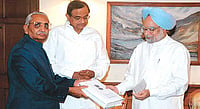
Just Decide, Will You?
Friends from other cities relentlessly question me these days about the “state of Hyderabad”. Obviously, they watch more TV than is good for them. Hyderabad, I assure you, is well, or as the old cliche goes, in the pink of health. Life, more or less, is what it always has been. Therefore, the rhetoric for and against the formation of Telangana is confined to newspapers and news channels. Life goes on uninterrupted. And if there are strikes and bandhs, these are part of the democratic process and are a sign of the robustness of democratic institutions and processes. They do cause some inconvenience, but life bounces back to normal. But arguments that are in the nature of political judgements about Telangana as well as the moral and ethical debate around formation of new states often tend to fudge the issue by conflating individual opinion on the agitation with the democratic right of people to agitate, do so peacefully and await an outcome with patience. It is patience that seems to be running thin in the city. People want the UPA government at the Centre to take a decision—any decision—so that people have a sense of clarity about the future. If there is one thing, however, which all of us missed when we looked at the UPA manifesto in 2009 was the word “decision”. An old Hyderabadi recently told me, “We are not asking for governance or good governance. Not even statesmanship or vision. Just a decision.”
Splendour in the Shadows
Hyderabad is home to the Jagdish and Kamla Mittal Museum of Indian Art. Yet no visitor to the city will be able to find it. It has one of the finest collections of Indian art and art objects in this country and in the world. What it does not have is visibility. Settling in Hyderabad in 1953, Jagdish and Kamla Mittal have spent a lifetime collecting these stunning pieces. Art collectors, critics and museums across the world have attested to the quality and worth of the drawings and paintings, as well as the bronze, ivory, glass, terracotta, wood and metal artefacts in this collection. Yet, no government or corporate has thought it fit to help Jagdishji build a museum to house this extraordinary collection. Jagdishji is 86 years old, and feels slightly let down by Hyderabad and Hyderabadis. He strongly feels that this collection ought to be viewed by people and ought to serve the needs of artists, historians and lovers of art. Hyderabad could do itself proud by transforming this magnificent private collection into a proud public tribute to two exceptional collectors and generous individuals. Hyderabad owes it to the Mittals, who have been generous patrons of the arts and crafts in the city for decades now.
Lord of the Flesh
I am re-reading the Kreedabhiraamamu of Vinukonda Vallabharaaya. The translators, Velcheru Narayana Rao and David Shulman, have titled it A Lover’s Guide to Warangal. It is a 15th century text, and is playful, erotic, transgressive and irreverent. It speaks of Sanskrit as the mother of all languages, but marks Telugu as the best language of the land. Does the writer exercise a choice in his selection of languages? He does, and that too is conveyed through erotic imagery: “Between the aged mother/ and the ravishing young daughter/ I’ll take the daughter any day!” In the realm of the erotic, all conventions of caste and religion are breached. The Brahmin in the story, who is pietistic and given to strict observance of rituals, is not beyond the way of all flesh when he asks an outcaste woman if he could “perform the rite of squeezing/ your magnificent pyramids of pleasure” and tells her that her “girdle holds the secret of ultimate reality revealed in the ancient Upanishad named Desire.” This is all a far cry from the politically correct, sanctimonious times we live in and very far, indeed, from what the Hindutva votaries would tell us what “real Hindu culture” is all about.
Neither does it reflect the sheer monotony that entered theological discourse in the 19th century with neo-Advaita and the constant prattling of the Brahman-Atman business, claiming that “all was one”. This transgressive power of the erotic is also evident in the poems of Annamayya, also of the 15th century, who lived in Tirupati. He has now been sanitised into a monotonous devotional poet. Here’s what Annamayya says of the Lord on the Hill: “You live up there on the hill like a lord/ You make couples happy, after love/ you tickle women between their breasts./ Don’t fan the fires of loneliness.”
Cock-a-doodle Dandy
My favourite from the Kreedabhiraamamu is this: ‘I had to work all night/ just to bring her round./ Just as I was about to kiss her/ at long last, I was cheated out of it/ by that goddamned rooster!’ The bird referred to here isn’t in fact a bird but the name of another woman that slips past our narrator’s mouth while he is still with his current object of desire.























